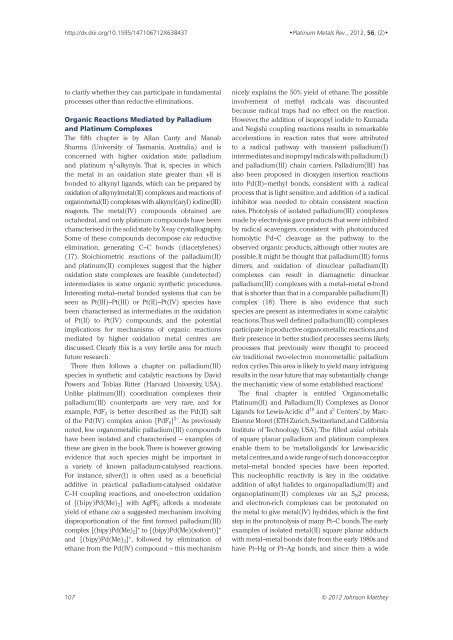Download article PDF - Platinum Metals Review
Download article PDF - Platinum Metals Review
Download article PDF - Platinum Metals Review
Create successful ePaper yourself
Turn your PDF publications into a flip-book with our unique Google optimized e-Paper software.
http://dx.doi.org/10.1595/147106712X638437<br />
•<strong>Platinum</strong> <strong>Metals</strong> Rev., 2012, 56, (2)•<br />
to clarify whether they can participate in fundamental<br />
processes other than reductive eliminations.<br />
Organic Reactions Mediated by Palladium<br />
and <strong>Platinum</strong> Complexes<br />
The fifth chapter is by Allan Canty and Manab<br />
Sharma (University of Tasmania, Australia) and is<br />
concerned with higher oxidation state palladium<br />
and platinum 1 -alkynyls. That is, species in which<br />
the metal in an oxidation state greater than +II is<br />
bonded to alkynyl ligands, which can be prepared by<br />
oxidation of alkynylmetal(II) complexes and reactions of<br />
organometal(II) complexes with alkynyl(aryl) iodine(III)<br />
reagents. The metal(IV) compounds obtained are<br />
octahedral, and only platinum compounds have been<br />
characterised in the solid state by X-ray crystallography.<br />
Some of these compounds decompose via reductive<br />
elimination, generating C–C bonds (diacetylenes)<br />
(17). Stoichiometric reactions of the palladium(II)<br />
and platinum(II) complexes suggest that the higher<br />
oxidation state complexes are feasible (undetected)<br />
intermediates in some organic synthetic procedures.<br />
Interesting metal–metal bonded systems that can be<br />
seen as Pt(III)–Pt(III) or Pt(II)–Pt(IV) species have<br />
been characterised as intermediates in the oxidation<br />
of Pt(II) to Pt(IV) compounds, and the potential<br />
implications for mechanisms of organic reactions<br />
mediated by higher oxidation metal centres are<br />
discussed. Clearly this is a very fertile area for much<br />
future research.<br />
There then follows a chapter on palladium(III)<br />
species in synthetic and catalytic reactions by David<br />
Powers and Tobias Ritter (Harvard University, USA).<br />
Unlike platinum(III) coordination complexes their<br />
palladium(III) counterparts are very rare, and for<br />
example, PdF 3 is better described as the Pd(II) salt<br />
of the Pd(IV) complex anion [PdF 6 ] 2– . As previously<br />
noted, few organometallic palladium(III) compounds<br />
have been isolated and characterised – examples of<br />
these are given in the book. There is however growing<br />
evidence that such species might be important in<br />
a variety of known palladium-catalysed reactions.<br />
For instance, silver(I) is often used as a beneficial<br />
additive in practical palladium-catalysed oxidative<br />
C–H coupling reactions, and one-electron oxidation<br />
of [(bipy)Pd(Me) 2 ] with AgPF 6 affords a moderate<br />
yield of ethane via a suggested mechanism involving<br />
disproportionation of the first formed palladium(III)<br />
complex [(bipy)Pd(Me) 2 ] + to [(bipy)Pd(Me)(solvent)] +<br />
and [(bipy)Pd(Me) 3 ] + , followed by elimination of<br />
ethane from the Pd(IV) compound – this mechanism<br />
nicely explains the 50% yield of ethane. The possible<br />
involvement of methyl radicals was discounted<br />
because radical traps had no effect on the reaction.<br />
However, the addition of isopropyl iodide to Kumada<br />
and Negishi coupling reactions results in remarkable<br />
accelerations in reaction rates that were attributed<br />
to a radical pathway with transient palladium(I)<br />
intermediates and isopropyl radicals with palladium(I)<br />
and palladium(III) chain carriers. Palladium(III) has<br />
also been proposed in dioxygen insertion reactions<br />
into Pd(II)–methyl bonds, consistent with a radical<br />
process that is light sensitive, and addition of a radical<br />
inhibitor was needed to obtain consistent reaction<br />
rates. Photolysis of isolated palladium(III) complexes<br />
made by electrolysis gave products that were inhibited<br />
by radical scavengers, consistent with photoinduced<br />
homolytic Pd–C cleavage as the pathway to the<br />
observed organic products, although other routes are<br />
possible. It might be thought that palladium(III) forms<br />
dimers, and oxidation of dinuclear palladium(II)<br />
complexes can result in diamagnetic dinuclear<br />
palladium(III) complexes with a metal–metal -bond<br />
that is shorter than that in a comparable palladium(II)<br />
complex (18). There is also evidence that such<br />
species are present as intermediates in some catalytic<br />
reactions. Thus well defined palladium(III) complexes<br />
participate in productive organometallic reactions, and<br />
their presence in better studied processes seems likely,<br />
processes that previously were thought to proceed<br />
via traditional two-electron monometallic palladium<br />
redox cycles. This area is likely to yield many intriguing<br />
results in the near future that may substantially change<br />
the mechanistic view of some established reactions!<br />
The final chapter is entitled ‘Organometallic<br />
<strong>Platinum</strong>(II) and Palladium(II) Complexes as Donor<br />
Ligands for Lewis-Acidic d 10 and s 2 Centers’, by Marc-<br />
Etienne Moret (ETH Zurich, Switzerland, and California<br />
Institute of Technology, USA). The filled axial orbitals<br />
of square planar palladium and platinum complexes<br />
enable them to be ‘metalloligands’ for Lewis-acidic<br />
metal centres, and a wide range of such donor-acceptor<br />
metal–metal bonded species have been reported.<br />
This nucleophilic reactivity is key in the oxidative<br />
addition of alkyl halides to organopalladium(II) and<br />
organoplatinum(II) complexes via an S N 2 process,<br />
and electron-rich complexes can be protonated on<br />
the metal to give metal(IV) hydrides, which is the first<br />
step in the protonolysis of many Pt–C bonds. The early<br />
examples of isolated metal(II) square planar adducts<br />
with metal–metal bonds date from the early 1980s and<br />
have Pt–Hg or Pt–Ag bonds, and since then a wide<br />
107 © 2012 Johnson Matthey
















